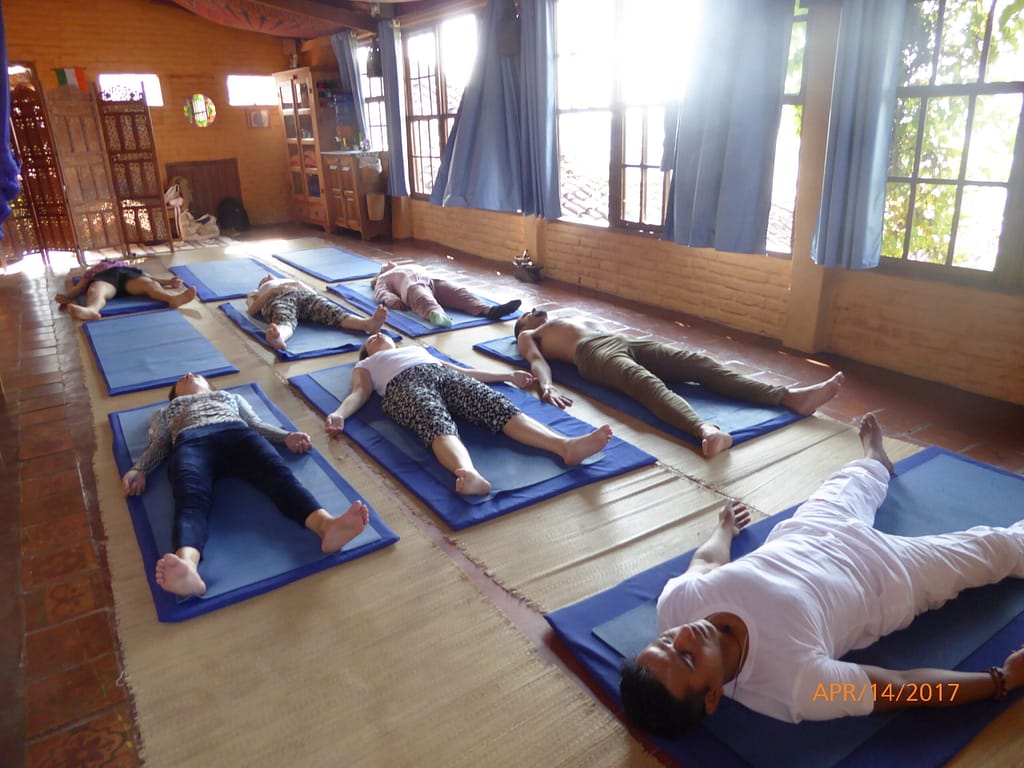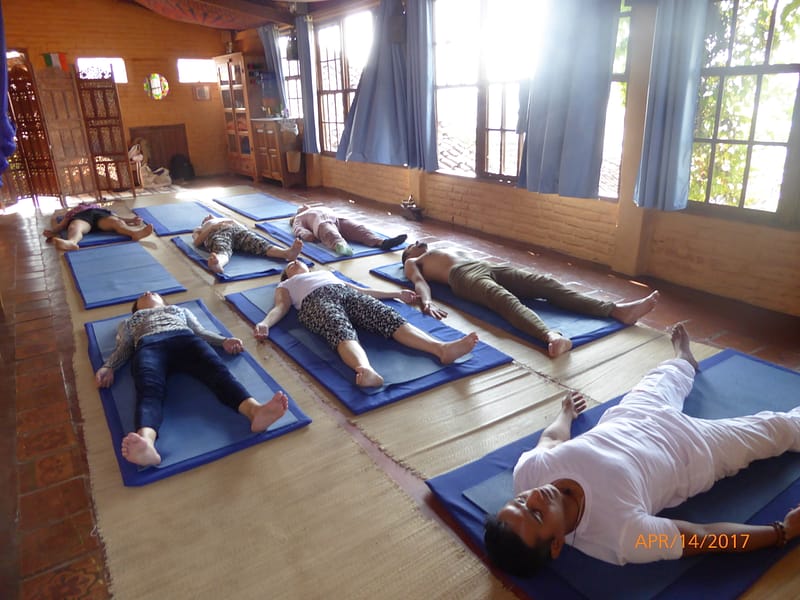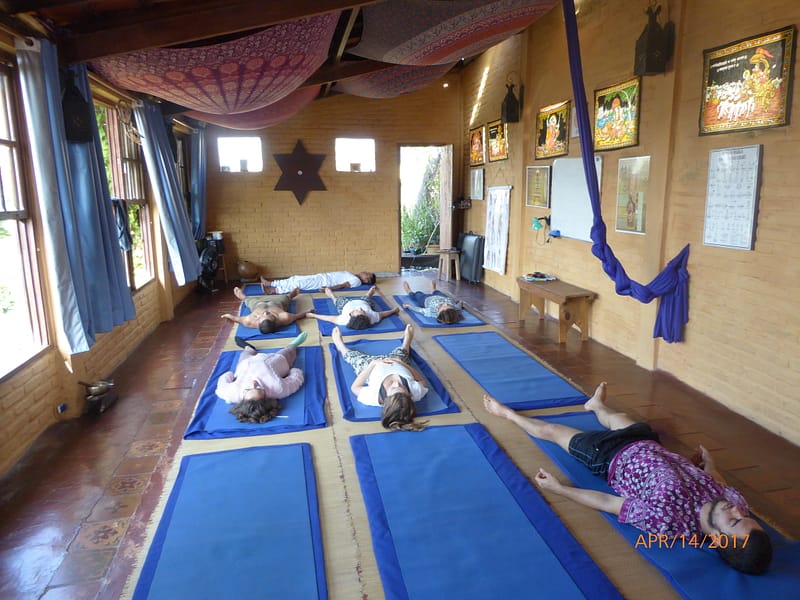Yoga Nidra
Table of Contents
What is Yoga Nidra?
Yoga Nidra is a Sanskrit term that translates to ‘yogic sleep.’ In yogic practices, it is effortless, superconscious sleep. Yogic sleep is the art of reaching the highest level of self-awareness.
Joga Nidra is highly suitable for all yoga practitioners and significantly changes daily life. It differs from regular sleep in which a practitioner is awake and aware of their inner self.
What happens during Yoga Nidra Meditation?
Yoga Nidra for sleep meditation is a form of guided meditation that aims to achieve the most profound state of meditation. It begins at the conscious level and progresses to the superconscious level. During nidra meditation, each person has a unique experience.
Yoga beginners experience a different state of mind. Joga Nidra brings a lot of wisdom and a sense of revealing the ultimate truth.
During our Yoga Teacher Training and 14-day yoga and meditation retreat programs, we encourage our students to attain the highest level of this ancient practice.
Where do Yog Nidra and Meditation come from?
India is the origin of yoga practices, and the six philosophies of Hinduism are the primary source of Yog Nidra. Patanjali formulated this practice in simple code. Sankhya’s philosophy aptly describes the concept of Yog Nidra.
Yoga sleep was a leading practice in the Indian subcontinent for strengthening physical, mental, and spiritual well-being. Vedanta philosophy and Kashmir Shaivism also have texts on yoga nidra and meditation.
How to do Yoga Nidra?
Yoga Nidra is one of the most accessible practices in the fundamentals of yoga. A certified yoga teacher does this practice. Joga Nidra takes about 30 minutes to 45 minutes, and it is practised in this formation: –
- Practice Nadi Shodan pranayama for 5 minutes to calm the nerves.
- Lie down in corpse pose (savasana) and take a rest.
- Please align your physical body and stay at ease.
- Start to focus on prana and relax the mind.
- Sohum breathing is very effective in yoga nidra. When you inhale, feel the vibrations of So (I am), and during exhalation, practice Hum (that).
- Your mind will be steady, and the frequencies will be low in intensity, and you will be capable of attaining a state of consciousness.
- Consistency in practice is a significant challenge. To progress further, deep silence will be required.
- You may feel the sensation of internal body parts and the organs through which the concentration will be improved.
- Now, you may start feeling the colours of chakras and their presence. This is almost similar to Reiki and Jin Shin Jyutsu healings.
- There will be a state when your mind is entirely focused, and you may easily disconnect your senses from other matters.
Four Stages of Consciousness(Chetna)
Particular yogic practices, such as Yoga Nidra, are used to expand our Chetna or consciousness during sleep stages. The above are the stages to practice Yog Nidra Meditation:
- The conscious state, or Jagrat Awastha, marks the beginning of practising Yogic Nidra, in which a person remains fully awake in the senses. At this point, a seeker can quickly feel physical appearance.
- Sleeping state or Nidra Awastha: A Sadhaka enters a sleeping state after breaking the external link. In this state, the physical appearance has disappeared.
- Dreamy state or Swapan Awastha: A dreamy state is considered a subconscious level of meditation in which a practitioner is attaining a higher spirit.
- Super-consciousness or Turiya Awastha: At this level, a Sadhaka is considered fully physically, mentally, and emotionally stable. This is the highest state of meditation to attain Ananda or bliss.
Stages of Yoga Nidra Meditation
Yog Nidra is a deep state of self-awakening in which a practitioner enters to identify objectives and gain a broad understanding of the self. It is practised in this hierarchy:
- To be present: This is the first practice as a Sadhaka (practitioner) realizes his physical formation to practice yogic sleep.
- Connect with the universe: A seeker is fully aware of the goals, only to connect with nature and to turn inward.
- Pranic presence: A person identifies the breathing pattern and works on correcting abnormal breathing to align with the vital force.
- Subconscious state of mind: Now, a Sadhaka moves inward and withdraws the senses’ insight to experience a subconscious state of mind.
- Dreamy state: After connecting with the subconscious state of mind, it is possible that the person would fall into a state of sleep. Many universal connections emerge in this state of practice.
- Self-awakening: There is a call during this state of mind, which makes the sensations of the deepest layer of the mind. This state is considered the visualization of the self.
- Turiya state of mind: It is the top state of yogic sleep in which the mind stays calm, and the consciousness attains the top level. At this level, it is very easy to travel astrally and roam around without carrying the physical body.
- Neutral state: After transmitting to all areas, a practitioner returns to a state where the physical body exists.
Yoga Nidra Benefits:
Yog Nidra has a deep effect on an individual. In regular practice, a person can quickly identify many experiences and improve their capabilities. The main benefits of yoga nidra are as follows:
- It is very effective to rest the body’s nervous system after practicing yoga asanas.
- Yog Nidra brings clarity to thoughts and provides a clear vision.
- It is highly suitable for attaining the most profound state of meditation.
- It improves the concentration level.
- People suffering from migraines and high BP should practice yoga nidra daily.
- It activates the brain cells, which sharpens memory.
- Someone who is suffering from insomnia may practice it before bed.
- Yogic sleep activates all the chakras, making it suitable for cleansing the body’s chakra system.
- Yogic nidra is one of the best ways to attain samadhi. It prepares the physical body to remain in one position for extended periods.
- Yog Nidra plays a vital role in reaching the level of superconsciousness.
- Yog Nidra brings joy, happiness, and compassion to the heart.
Precautions for practising Yoga Nidra
Although Yog Nidra meditation offers numerous benefits for the human body, it has a few limitations. If someone is passing through these phases, they should follow some precautions, and these are:
- Yoga Nidra should never be practised just after meals. Before practising it, the meal should be light and sattvic.
- It should not be practised under the influence of alcohol or any other harmful substances.
- Someone who is practising yog nidra should have an open and clean space.
- It should never be practiced under any negative influence, as it can have a profoundly positive impact on our personality.
- Practising it in a silent zone where noise does not interrupt during practice is highly advisable.
- Practising it after covering the body parts properly is also very important.
- Yoga sleep should be avoided if a person is having a lot of anger.
- An experienced yoga teacher or guru should always practise it.
Tags:




